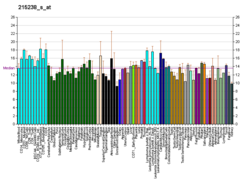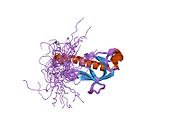Protein found in humans
| DOCK9 |
|---|
 |
| Available structures |
|---|
| PDB | Ortholog search: PDBe RCSB |
|---|
| List of PDB id codes |
|---|
1WG7, 2WM9, 2WMN, 2WMO |
|
|
| Identifiers |
|---|
| Aliases | DOCK9, ZIZ1, ZIZIMIN1, Dock9, dedicator of cytokinesis 9 |
|---|
| External IDs | OMIM: 607325; MGI: 106321; HomoloGene: 41026; GeneCards: DOCK9; OMA:DOCK9 - orthologs |
|---|
| Gene location (Human) |
|---|
 | | Chr. | Chromosome 13 (human)[1] |
|---|
| | Band | 13q32.3 | Start | 98,793,429 bp[1] |
|---|
| End | 99,086,625 bp[1] |
|---|
|
| Gene location (Mouse) |
|---|
 | | Chr. | Chromosome 14 (mouse)[2] |
|---|
| | Band | 14 E5|14 65.28 cM | Start | 121,779,458 bp[2] |
|---|
| End | 122,035,249 bp[2] |
|---|
|
| RNA expression pattern |
|---|
| Bgee | | Human | Mouse (ortholog) |
|---|
| Top expressed in | - Achilles tendon
- right lung
- corpus callosum
- Region I of hippocampus proper
- lower lobe of lung
- oral cavity
- sural nerve
- skin of hip
- inferior olivary nucleus
- upper lobe of lung
|
| | Top expressed in | - subiculum
- right lung lobe
- sciatic nerve
- CA3 field
- cerebellar vermis
- Region I of hippocampus proper
- lobe of cerebellum
- tunica adventitia of aorta
- deep cerebellar nuclei
- endothelial cell of lymphatic vessel
|
| | More reference expression data |
|
|---|
| BioGPS | 

 | | More reference expression data |
|
|---|
|
| Gene ontology |
|---|
| Molecular function | - protein binding
- guanyl-nucleotide exchange factor activity
- cadherin binding
| | Cellular component | - cytosol
- endomembrane system
- membrane
| | Biological process | - blood coagulation
- small GTPase mediated signal transduction
- positive regulation of GTPase activity
- biological process
| | Sources:Amigo / QuickGO |
|
| Orthologs |
|---|
| Species | Human | Mouse |
|---|
| Entrez | | |
|---|
| Ensembl | | |
|---|
| UniProt | | |
|---|
| RefSeq (mRNA) | NM_001130048
NM_001130049
NM_001130050
NM_015296
NM_001318849
|
|---|
NM_001366676
NM_001366677
NM_001366678
NM_001366679
NM_001366680
NM_001366681
NM_001366682
NM_001366683
NM_001366684 |
| |
|---|
NM_001081039
NM_001128307
NM_001128308
NM_134074
NM_001347596 |
|
|---|
| RefSeq (protein) | NP_001123520
NP_001123521
NP_001123522
NP_001305778
NP_056111
|
|---|
NP_001353605
NP_001353606
NP_001353607
NP_001353608
NP_001353609
NP_001353610
NP_001353611
NP_001353612
NP_001353613 |
| |
|---|
| Location (UCSC) | Chr 13: 98.79 – 99.09 Mb | Chr 14: 121.78 – 122.04 Mb |
|---|
| PubMed search | [3] | [4] |
|---|
|
| Wikidata |
| View/Edit Human | View/Edit Mouse |
|
Dedicator of cytokinesis protein 9 (Dock9), also known as Zizimin1, is a large (~230 kDa) protein encoded in the human by the DOCK9 gene, involved in intracellular signalling networks.[5] It is a member of the DOCK-D subfamily of the DOCK family of guanine nucleotide exchange factors that function as activators of small G-proteins. Dock9 activates the small G protein Cdc42.
Discovery
Dock9 was discovered using an affinity proteomic approach designed to identify novel activators of the small G protein Cdc42 in fibroblasts.[6] Subsequent northern blot analysis revealed that Dock9 is expressed primarily in the brain, heart, skeletal muscle, kidney, placenta and lung. Lower levels were detected in the colon, thymus, liver, small intestine and in leukocytes from peripheral blood.
Structure and function
Dock9 shares a similar structure of two core domains (known as DHR1 and DHR2), which are shared by all DOCK family members. The C-terminal DHR2 domain functions as an atypical GEF domain for small G proteins (see Dock180: structure and function) and the DHR1 domain is known, in some DOCK-A/B/C subfamily proteins, to be involved in their recruitment to the plasma membrane. Unlike DOCK-A/B/C proteins DOCK-D proteins (including Dock9) contain an N-terminal pleckstrin homology (PH) domain that mediates their recruitment to the membrane.[7] Dock9, along with other DOCK-C/D subfamily members, can activate Cdc42 in vitro and in vivo via its DHR2 domain.[6] However, Dock9 adopts an autoinhibitory conformation that masks the DHR2 domain in its resting state.[7] The mechanism by which this autoinhibition is overcome is still unclear although in some other DOCK proteins, which also undergo autoinhibition, it requires an interaction with adaptor proteins such as ELMO.[8][9] Dock9 has also been reported to dimerise, under resting conditions, via its DHR2 domains and this study suggests that other DOCK family proteins may also behave in the same way.[10] Recent analysis of a chromosomal region associated with susceptibility to bipolar disorder revealed that single nucleotide polymorphisms in the DOCK9 gene contribute to the risk and severity of this condition.[11]
References
- ^ a b c GRCh38: Ensembl release 89: ENSG00000088387 – Ensembl, May 2017
- ^ a b c GRCm38: Ensembl release 89: ENSMUSG00000025558 – Ensembl, May 2017
- ^ "Human PubMed Reference:". National Center for Biotechnology Information, U.S. National Library of Medicine.
- ^ "Mouse PubMed Reference:". National Center for Biotechnology Information, U.S. National Library of Medicine.
- ^ "Entrez Gene: DOCK9 dedicator of cytokinesis 9".
- ^ a b Meller N, Irani-Tehrani M, Kiosses WB, et al. (September 2002). "Zizimin1, a novel Cdc42 activator, reveals a new GEF domain for Rho proteins". Nat. Cell Biol. 4 (9): 639–47. doi:10.1038/ncb835. PMID 12172552. S2CID 24507862.
- ^ a b Meller N, Westbrook MJ, Shannon JD, et al. (January 2008). "Function of the N-terminus of zizimin1: autoinhibition and membrane targeting". Biochem. J. 409 (2): 525–33. doi:10.1042/BJ20071263. PMC 2740492. PMID 17935486.
- ^ Lu M, Kinchen JM, Rossman KL, et al. (August 2004). "PH domain of ELMO functions in trans to regulate Rac activation via Dock180". Nat. Struct. Mol. Biol. 11 (8): 756–62. doi:10.1038/nsmb800. PMID 15247908. S2CID 125990.
- ^ Lu M, Kinchen JM, Rossman KL, et al. (February 2005). "A Steric-inhibition model for regulation of nucleotide exchange via the Dock180 family of GEFs". Curr. Biol. 15 (4): 371–77. Bibcode:2005CBio...15..371L. doi:10.1016/j.cub.2005.01.050. PMID 15723800.
- ^ Meller N, Irani-Tehrani M, Ratnikov BI, et al. (September 2004). "The novel Cdc42 guanine nucleotide exchange factor, zizimin1, dimerizes via the Cdc42-binding CZH2 domain". J. Biol. Chem. 279 (36): 37470–76. doi:10.1074/jbc.M404535200. PMID 15247287.
- ^ Detera-Wadleigh SD, Liu CY, Maheshwari M, et al. (October 2007). "Sequence variation in DOCK9 and heterogeneity in bipolar disorder". Psychiatr. Genet. 17 (5): 274–86. doi:10.1097/YPG.0b013e328133f352. PMID 17728666. S2CID 7102906.
Further reading
- Nakajima D, Okazaki N, Yamakawa H, et al. (2003). "Construction of expression-ready cDNA clones for KIAA genes: manual curation of 330 KIAA cDNA clones". DNA Res. 9 (3): 99–106. doi:10.1093/dnares/9.3.99. PMID 12168954.
- Kwofie MA, Skowronski J (2008). "Specific recognition of Rac2 and Cdc42 by DOCK2 and DOCK9 guanine nucleotide exchange factors". J. Biol. Chem. 283 (6): 3088–96. doi:10.1074/jbc.M705170200. PMID 18056264.
- Meller N, Westbrook MJ, Shannon JD, et al. (2008). "Function of the N-terminus of zizimin1: autoinhibition and membrane targeting". Biochem. J. 409 (2): 525–33. doi:10.1042/BJ20071263. PMC 2740492. PMID 17935486.
- Detera-Wadleigh SD, Liu CY, Maheshwari M, et al. (2007). "Sequence variation in DOCK9 and heterogeneity in bipolar disorder". Psychiatr. Genet. 17 (5): 274–86. doi:10.1097/YPG.0b013e328133f352. PMID 17728666. S2CID 7102906.
- Gerhard DS, Wagner L, Feingold EA, et al. (2004). "The status, quality, and expansion of the NIH full-length cDNA project: the Mammalian Gene Collection (MGC)". Genome Res. 14 (10B): 2121–7. doi:10.1101/gr.2596504. PMC 528928. PMID 15489334.
- Dunham A, Matthews LH, Burton J, et al. (2004). "The DNA sequence and analysis of human chromosome 13". Nature. 428 (6982): 522–8. Bibcode:2004Natur.428..522D. doi:10.1038/nature02379. PMC 2665288. PMID 15057823.
- Ota T, Suzuki Y, Nishikawa T, et al. (2004). "Complete sequencing and characterization of 21,243 full-length human cDNAs". Nat. Genet. 36 (1): 40–5. doi:10.1038/ng1285. PMID 14702039.
- Strausberg RL, Feingold EA, Grouse LH, et al. (2003). "Generation and initial analysis of more than 15,000 full-length human and mouse cDNA sequences". Proc. Natl. Acad. Sci. U.S.A. 99 (26): 16899–903. Bibcode:2002PNAS...9916899M. doi:10.1073/pnas.242603899. PMC 139241. PMID 12477932.
- Côté JF, Vuori K (2003). "Identification of an evolutionarily conserved superfamily of DOCK180-related proteins with guanine nucleotide exchange activity". J. Cell Sci. 115 (Pt 24): 4901–13. doi:10.1242/jcs.00219. PMID 12432077. S2CID 14669715.
- Meller N, Irani-Tehrani M, Kiosses WB, et al. (2002). "Zizimin1, a novel Cdc42 activator, reveals a new GEF domain for Rho proteins". Nat. Cell Biol. 4 (9): 639–47. doi:10.1038/ncb835. PMID 12172552. S2CID 24507862.
- Kikuno R, Nagase T, Ishikawa K, et al. (1999). "Prediction of the coding sequences of unidentified human genes. XIV. The complete sequences of 100 new cDNA clones from brain which code for large proteins in vitro". DNA Res. 6 (3): 197–205. doi:10.1093/dnares/6.3.197. PMID 10470851.
 | This article on a gene on human chromosome 13 is a stub. You can help Wikipedia by expanding it. |

 1wg7: Solution structure of pleckstrin homology domain from human KIAA1058 protein
1wg7: Solution structure of pleckstrin homology domain from human KIAA1058 protein





















